
views
Take inventory.
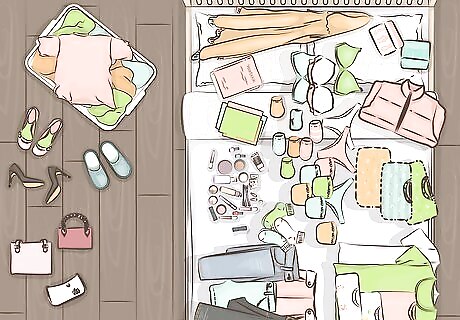
Take out and inspect all of the items in your room. It might just feel like you’re making a bigger mess, but taking out all of your items and laying them out gives you a clean slate to begin reorganizing them. This is also a great way to see what items you might want to get rid of or donate. Finally, taking inventory gives you an idea of what kinds of organizers or storage bins you might be able to use for certain items. Remove everything from your closet, desk, and dresser and place them on the floor, your bed, or even take them outside of your room for the time being. If taking everything out of its place at once is overwhelming and is taking up too much space, work section by section. Start from the areas that are easiest to organize and work your way up to the more difficult areas.
Choose which items you’ll keep, store, donate, and throw out.
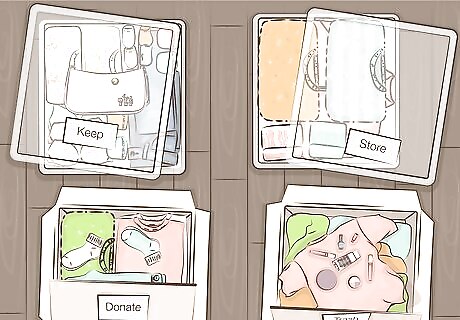
Get rid of or store the items you don’t use frequently. As you’re sorting through your items, you’ll likely come across more than a few things that you’ve hardly touched in the last few months or even years. Use plastic bins or cardboard boxes and label them “Keep,” “Store,” and “Donate,” and “Throw Out.” Get rid of as many items as possible to keep your clutter at a minimum. Keep: The items that you keep will be items that you use on a regular basis. If you've used the item in the last two or three months, keep it. Store: These are things that you can't bear to throw away, such as something with sentimental value, but rarely use. Store these items in the back of your closet, attic, or basement. Donate: These are items that may benefit someone but you don’t personally need or use anymore. These may be things like clothes that don’t fit or old textbooks. Trash: These are items that no one will likely use—including you. If the item is broken or ruined in some way, or you can’t remember when you last used it, toss it. Use the 20-second rule to help you sort items. If you have to spend more than twenty seconds looking at an item and asking yourself if you'll ever use it again, the answer is probably no.
Come up with a system to organize the clothes in your closet.
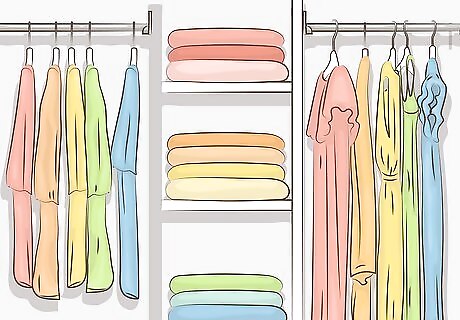
Organize your clothes in a way that makes them easy to find. One idea is to organize your clothes by season and continuously rotate them as the seasons change. For example, keep your summer clothes at the front and put your winter clothes toward the back during the warmer seasons. If you don’t have room in your closet for off-season clothes, put them in a bin or somewhere else in your room, such as a dresser. Another option is to sort your clothes by color as well as by season. For example, sort out all your summer clothes and put them in color order (red, orange, yellow, green, blue, etc.). Keep similar clothing items together. For example, group t-shirts, sweatshirts, and dresses together in separate spots in your closet. Use colored hangers to help you sort your clothes by garment. For example, put t-shirts on green hangers, dress shirts on black, and sweatshirts on blue. There are also a variety of different closet organizers that are easy to put up and can help keep your clothes well-organized.
Utilize the upper and lower spaces in your closet.
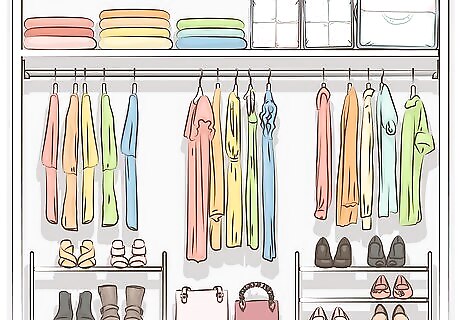
Fit more items into your closet by using all the available space. If you hang up your clothes in your closet, you’ll likely be left with quite a bit of unoccupied space on the floor and above your clothes. Use this space to store other items. For example, put a shoe rack at the bottom of your closet, or install a shelf above your clothes to hold folded pants and shorts. Place a dresser in your closet if you have the space. If you have a door that opens instead of a sliding door, invest in a hanging shoe rack or jewelry holder to put on your door. If your closet doesn’t have this type of door, another option is to hang a rack on the back of your bedroom door.
Organize your dresser into sections.
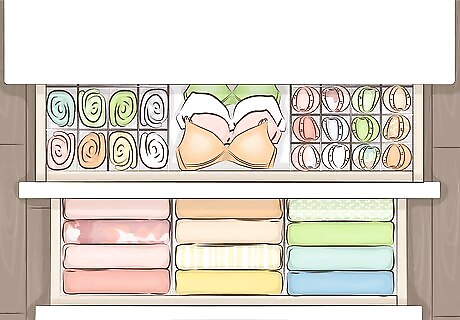
Section off specific spaces for certain garments. Look at how much space you have available in your dresser and decide what items will go where. For example, designate specific places for socks, underwear, and folded t-shirts. If you want to store other garments in your dresser, choose items that won’t wrinkle as easily after being folded, such as pajamas and workout clothes. Place small bins or dividers in each drawer to help keep your items separated. If you don’t want to buy new organizers, repurpose something like an old shoe box to store things like your socks in. Don’t forget to keep the top of your dresser clean and organized. Use things like jewelry boxes, mason jars, or other small storage containers to keep small items organized.
Group together like items in your desk.
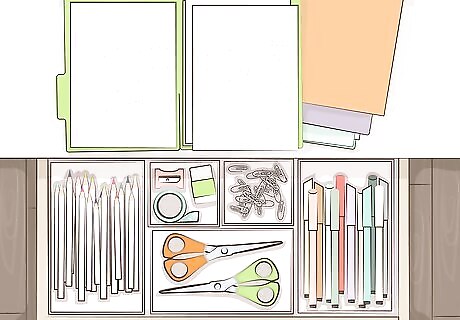
Make sure every item on your desk has a designated place. If you have a desk in your room that tends to get cluttered, organize it by grouping like items together. For example, keep all of your pens and pencils together in something like a mug and keep papers organized in file folders. Place other office supplies like staplers and scissors in your desk’s drawers. If you want to cut down on paper waste, consider digitalizing all of your documents and paperwork and storing them on your computer. Spring for a desk organizer to hold all of your office supplies in one convenient spot. Keep the clutter on top of your desk to a minimum. Leave most of your desk empty so you have more room to work. Another option is to use an organizer cart to store your supplies. This is a great option because you can easily move it to different spots around your room.
Utilize storage space under your bed.
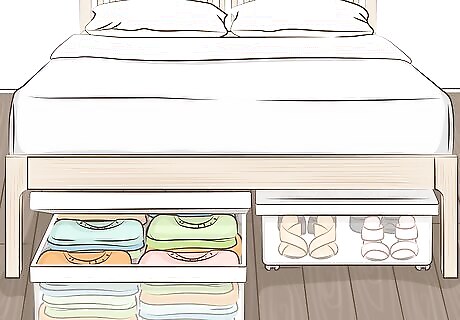
Store items in bins under your bed. You may not spare the underside of your bed that much thought, but it’s actually an extremely convenient and roomy storage space. However, instead of just shoving items under your bed, invest in some flat storage bins that you can easily slide in and out. Keep things like off-season clothes, extra office supplies, or shoes under here. If you’re worried about forgetting what you stored under your bed, opt for clear storage containers that you can easily see into.
Make your bed.
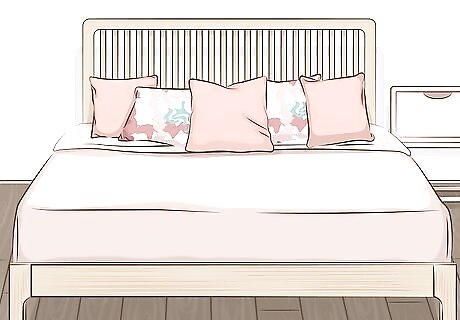
Make your bed every morning to motivate you to stay organized. A freshly made bed can go a long way in making your entire room look more put together, and it can remind you to keep the rest of your room clean. It’s also possible that some clutter may have piled up on your bed. If you have any blankets, stuffed animals, or pillows that you don’t feel like you need, store, donate, or throw them out if they’re not in good condition.
Deep clean of your room.
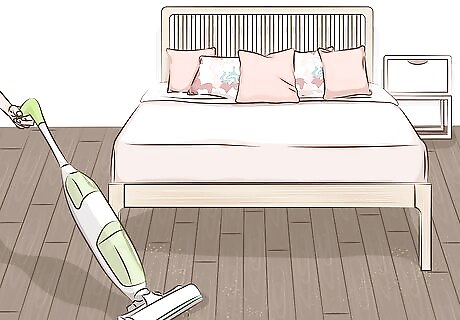
Clean your entire room once everything is in place. Once you’ve put everything in its rightful place, take some extra time to clean the floor by vacuuming or sweeping. Dust off each of your furniture pieces and wash your bed sheets and linens. By the end, not only will your room be well-organized, but it’ll be sparkling clean as well.
Take advantage of empty wall space.
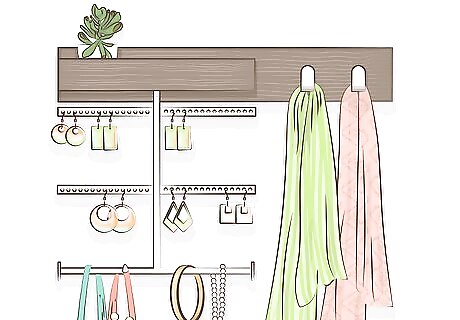
Hang various clothing or accessory organizers on your walls. Your bedroom’s walls are great places to hang things like jewelry organizers or hooks to place things like hats, purses, and coats on. Another idea is to put up some shelving units for things like books and small trinkets. Be sure not to let your walls get too cluttered. For example, take down any old posters, photos, or decor that you no longer want to keep up.
Opt for furniture with built-in storage space.

Look for furniture with lots of drawers or hidden storage space. If you’re in the market for new bedroom furniture or want to add a few aesthetic pieces to your room, make sure to look at items that come with storage space already built in. For example, look for nightstands or vanities with drawers, bookshelves with lots of space, or ottomans that also double as storage containers. When arranging your furniture, make sure everything is logically and functionally organized. For example, put your dresser near your closet so that all of your clothing is close together.
Put items back in their designated spots after using them.
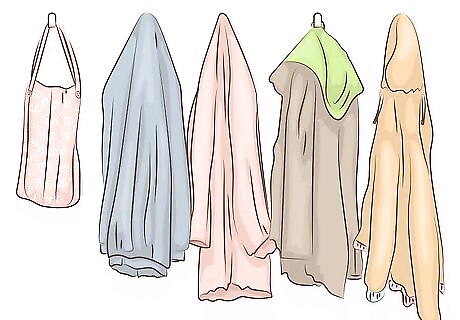
Maintain organization by putting items back where they belong. Don’t let all of your hard work go to waste by not sticking to your organizational plan! As you go about your daily life, make an effort to always return items to their proper places and continue to sort items according to your system. Create a routine for yourself to follow, such as always putting your jacket on its hook when you come home or throwing your dirty laundry in the hamper at the end of the day. One tip for keeping your clothes organized is to put laundry away as soon as it’s done. The longer you leave it sitting out, the less likely you’ll be to sort it properly.
Spend time each day organizing your room.
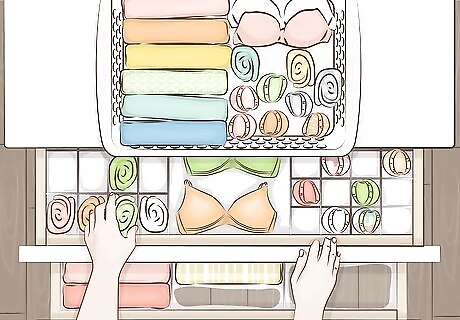
Take 5-10 minutes each day to clean your room. Organization and cleaning aren’t just one-and-done deals. To keep your room looking aesthetically organized and spotless, spend a little bit of time each night making sure everything is in its proper place. Make a cleaning routine as well, such as taking out the trash, dusting, and making your bed each morning.














Comments
0 comment